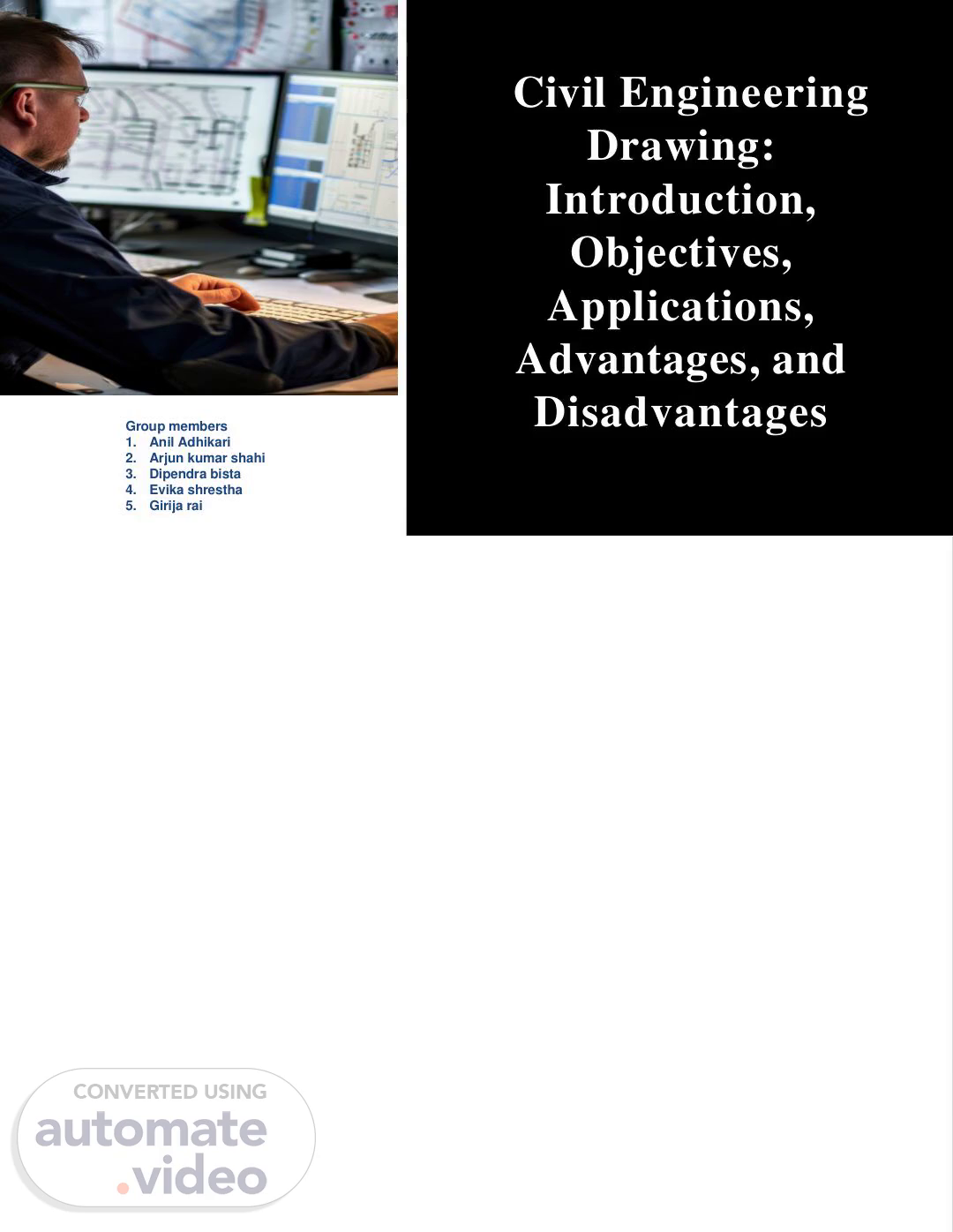Scene 1 (0s)
[Virtual Presenter] Civil Engineering Drawing: Introduction, Objectives, Applications, Advantages, and Disadvantages Group members 1. Anil Adhikari 2. Arjun kumar shahi 3. Dipendra bista 4. Evika shrestha 5. Girija rai.
Scene 2 (23s)
[Audio] Introduction to Civil Engineering Drawing Civil engineering drawing is a specialized form of technical drawing that represents the design and construction of infrastructure projects such as bridges, roads, buildings, and other public works. These drawings use standardized symbols and notations to convey precise information about dimensions, materials, and construction techniques. They serve as essential communication tools between engineers, architects, contractors, and other stakeholders, ensuring that all parties have a clear understanding of the project's requirements and specifications. Through civil engineering drawings, complex ideas are translated into visual representations, facilitating the planning, execution, and maintenance of civil engineering projects..
Scene 3 (1m 9s)
[Audio] Objectives of Civil Engineering Drawing 1. Facilitate clear communication between project stakeholders. 2. Accurately represent design intent and specifications. 3. Provide precise measurements and dimensions. 4. Guide construction processes. 5. Ensure compliance with regulations and standards. 6. Minimize construction errors. 7. Coordinate various project systems (e.g., structural, electrical). 8. Serve as official project documentation. 9. Assist in cost estimation. 10. Support project planning and analysis..
Scene 4 (1m 57s)
[Audio] Applications in the Field 1. Site layout and design plans 2. Structural framework drawings 3. Building floor plans and elevations 4. Road and highway design 5. Utility system layouts 6. Drainage and stormwater management 7. Geotechnical and foundation designs 8. Bridge design details 9. Construction sequencing plans 10. Renovation and maintenance documentation.
Scene 5 (2m 31s)
[Audio] Advantages of Civil Engineering Drawing 1. Clear Communication: Enhances understanding among project stakeholders. 2. Precision: Provides accurate measurements and details, reducing errors. 3. Regulatory Compliance: Ensures adherence to building codes and standards. 4. Cost Efficiency: Aids in budget estimation and resource management. 5. Visual Representation: Offers a clear visual of the project for better analysis and decision-making. 6. Construction Guidance: Serves as a roadmap for construction teams, improving workflow. 7. Error Minimization: Reduces misunderstandings that can lead to costly mistakes. 8. Documentation: Provides official records for future reference and modifications. 9. Project Coordination: Facilitates coordination among various disciplines in construction. 10. Enhanced Planning: Assists in effective project planning and scheduling..
Scene 6 (3m 45s)
[Audio] Disadvantages of Civil Engineering Drawing 1. Time-Consuming: Creating detailed drawings can require significant time and effort. 2. Complexity: Intricate designs may be difficult to interpret, leading to misunderstandings. 3. Costly Revisions: Changes in design may necessitate costly redraws and updates. 4. Dependence on Technology: Requires specialized software and tools, which can be expensive. 5. Skill Requirement: Demands a high level of expertise and training to create accurate drawings. 6. Limited Flexibility: Static drawings may not easily adapt to changes during construction. 7. Potential for Errors: Human errors in drawing can lead to significant construction issues. 8. Over-reliance on Drawings: May lead to neglect of on-site judgment and adjustments. 9. Maintenance of Drawings: Keeping drawings up to date can be challenging, especially for large projects. 10. Environmental Factors: May not fully account for sitespecific conditions that can affect construction..
Scene 7 (5m 41s)
[Audio] Technological Advancements Technological advancements in civil engineering drawing have significantly transformed the field, enhancing efficiency and accuracy. The adoption of Computer-Aided Design (CAD) software allows for precise drafting and 3D modeling, enabling engineers to visualize projects in greater detail. Building Information Modeling (BIM) further revolutionizes the process by integrating physical and functional characteristics of structures, facilitating collaboration among stakeholders and improving project management. Additionally, advancements in Geographic Information Systems (GIS) enable better site analysis and planning by providing spatial data visualization. Drones and laser scanning technology enhance site surveying, capturing high-resolution data for more accurate drawings. Together, these technologies streamline workflows, reduce errors, and foster innovation in civil engineering design and construction..
Scene 8 (6m 47s)
[Audio] Future Trends in Drawing . 1. Building Information Modeling (BIM): Increased use of BIM for integrated project delivery and collaboration. 2. **3D Printing**: Adoption of 3D printing technology for rapid prototyping and construction. 3. **Augmented Reality (AR) and Virtual Reality (VR)**: Enhanced visualization and simulation of projects for better stakeholder engagement. 4. **Cloud Computing**: Cloud-based platforms for real-time collaboration and access to drawings and data. 5. **Artificial Intelligence (AI)**: Use of AI for predictive analysis, design optimization, and automated drawing generation. 6. **Sustainability Focus**: Integration of sustainable design practices and materials in drawing processes. 7. **Smart Infrastructure**: Incorporation of smart technology in designs for enhanced functionality and maintenance. 8. **Geospatial Technologies**: Increased utilization of GIS and remote sensing for improved site analysis and planning. 9. **Automation and Robotics**: Use of automation in drafting processes and robotic construction methods. 10. **Data Analytics**: Leveraging data analytics for informed decision-making and enhanced project performance..
Scene 9 (8m 35s)
[Audio] Conclusion In conclusion, Civil Engineering Drawing is a fundamental aspect of civil engineering that facilitates , enhances , and supports project execution. Understanding its , , and challenges is vital for professionals in the field..
